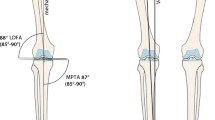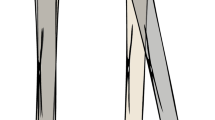Conclusion
Due to the absence of a unique center of rotation, the knee requires more complex geometry in its prosthetic replacement. The relative motions of the components are a combination of rolling and sliding, so causing a much more complex wear, whose debris remain trapped between articulating surfaces, producing three-body wear. Contact areas smaller than in total hip prosthesis can lead to more pronounced creep and greater possibility of local fatigue cracks developing. Where there is severe loss of articular cartilage but the normal bony structure is preserved, procedures that involve lowest resection of bone from both the femur and the tibia must be utilized, because the implant designs that require a great deal of excavation, so producing large cavities in the femur and in the tibia, leave relatively insufficient bone stock for revision or arthrodesis. Long stems require a large amount of intramedullary cement for fixation that may create difficulties in case of infection. If a prosthetic component becomes loose, the cement attached to it may abrade and destroy the surrounding bone and create an even larger cavity, which makes revision impossible or arthrodesis difficult to achieve. Finally, it is essential to restore the normal tibiofemoral valgus angle, because an eccentrically loaded tibial component on either the medial or lateral aspect can produce uneven wear and early loosening. So, jigs and guides which make it as easy as possible to resect the bone surfaces with precision have to be available. At present, there is a multitude of implants on the market. The selection of a prosthesis depends on many factors, including the surgeon’s preference and his familiarity with the device.
Access this chapter
Tax calculation will be finalised at checkout
Purchases are for personal use only
Preview
Unable to display preview. Download preview PDF.
Similar content being viewed by others
References
Ainsworth, R., Farling, G., Bardos, D. 1977. An improved bearing material for joint replacement prostheses: Carbon fiber reinforced UHMW polyethylene, Trans Orthop. Res. Soc. 2, 120.
Ambrosio, L., Carotenuto, G., Nicolais, L., Ronca, D. 1996. Degradation of explanted UHMW-PE components prostheses. Biomaterials 10(1–2), 15–23.
Andriacchi, T.P., Galante, J.O., Fermier, B.S. 1982. The influence of total knee replacement design on walking and stair climbing, J. Bone Jt. Surg. 64A, 1328–1335.
Bargren, J.H., Blaha, J.D., Freeman, M.A.R. 1983. Alignment in total knee arthroplasty: correlated biomechanical and clinical observations, Clin. Orthop. 173, 178–183.
Bartel, D.L., Burstein, A.H., Santavicca, E.A., Insall, J.N. 1982. Performance of the tibial component in total knee replacement, J. Bone Jt. Surg. 64A, 1026–1033.
Bartel, D.L., Burstein, A.H., Toda, M.D, Edwards, D.L. 1985. The effects of conformity and plastic thickness on contact stress in metal-backed plastic implants, J. Biomech. Eng. 107, 193–199.
Bartel, D.L., Bicknell, V.L., Wright, T.M. 1986. The effect of conformity, thickness and material stresses in ultra-high molecular weight components for total joint replacement, J. Bone Jt. Surg. 68A, 1041–1051.
Bartel, D.L., Rawlinson, J.J., Burstein, A.H., Ranawatt, C.S., Flynn, W.F. 1995. Stresses in polyethylene components of contemporary total knee replacements, Clin. Orthop. 317, 76–82.
Batheja, S.K., Andrews, E.H., Yarbrough, S.M. 1989. Radiation induced crystallinity in linear polyethylenes: Long term aging effects, Polym. J. 21, 739–750.
Bayley, J.C., Scott, R.D., Ewald, F.C, Holmes, G.B. Jr. 1988. Metal-backed patellar component failure following total knee replacement, J. Bone Jt. Surg. 70A, 668–674.
Binderglass, D.F., Cohen, J.L., Dorr, L.D. 1993. Patellar tilt and subluxation in total knee arthroplasty. Relationship to pain, fixation and design. Clin. Orthop. 286, 103–109.
Blaha, J.D., Insler, H.P., Freeman, M.A.R. 1982. The fixation of a proximal tibial polyethylene prosthesis without cement, J. Bone Jt. Surg. 64B, 326–335.
Blunn, G.W., Walker, P.S., Joshi, A., Hardinge, K. 1991. The dominance of cyclic sliding in producing wear in total knee replacements, Clin. Orthop. 273, 253–260.
Cates, H.E., Ritter, M.A., Keating, E.M., Faris, P.M. 1993. Intramedullary versus extramedullary femoral alignment systems in total knee replacement. Clin. Orthop. 286, 32–39.
Charnley, J. 1960. Anchorage of the femoral head prosthesis to the shaft of the femur, J. Bone Jt. Surg. 42B, 28–30.
Charnley, J. 1970. Low friction arthroplasty, Clin. Orthop. 72, 7–21.
Connelly, G.M., Rimnac, C.M., Wright, T.M., Hertzberg, R.W., Manson, J.A. 1984. Fatigue crack propagation behavior of ultrahigh molecular weight polyethylene, J. Orthop. Res. 2, 119–125.
Coventry, M.B., Finerman, G.H., Riley, L.H., Turner, R.H., Upshaw, J.E. 1972. A new geometric knee for total knee arthroplasty, Clin. Orthop. 83, 157–162.
Denham, R.A, Bishop, R.E.D. 1978. Mechanics of the knee and problems in reconstructive surgery, J. Bone Jt. Surg. 60B, 308–309.
Engelbrecht, E., Zippel, J. 1973. The sledge prosthesis “Model St. Georg”. Acta Orthop. Belg. 39, 203–209.
Feng, E.L., Stulberg, D.S., Wixon, R.S. 1995. Progressive subluxation and polyethylene wear in total knee replacements with flat articular surfaces, Clin. Orthop. 205, 43–48.
Figgie, H.E., Goldberg, V.M., Heiple, K.G., Moller, H.S., Gordon, N.H. 1989. The influence of tibial-patellofemoral location on function of the knee in patients with posterior stabilized condylar knee prostheses, J. Bone Jt. Surg. 68A, 1035–1040.
Font-Rodriguez, D.E., Scuderi, G.R., Insall, J.N. 1997. Survivorship of cemented total knee arthroplasty, Clin. Orthop. 345, 79–86.
Freeman, M.A.R., Swanson, S.A., Tood, R. 1973. Total replacement of the knee using the Freeman-Swanson knee prosthesis, Clin. Orthop. 94, 153–170.
Glück, T. 1890. Die invaginationsmethode der osteo-und arthroplastik, Berl. Klin. Wochenschr. Circulation 33, 752.
Goodfellow, J., O’Connor, J., 1978. The mechanics of the knee and the prosthesis design, J. J. Bone Jt. Surg. 60B, 358–369.
Gunston, F.H. 1973. Polycentric knee arthroplasty, Clin. Orthop. 94, 128–135.
Hirakawa, K., Bauer, T.W., Stulberg, B.N., Wilde, A.H., Borden, L.S. 1996. Characterization of debris adjacent to failed knee implants of 3 different designs, Clin. Orthop. 331, 151–158.
Insall, J.N., Walker, P. 1976. Unicondylar knee replacement, Clin. Orthop. 120, 83–85.
Insall, J.N., Ranawat, C.S., Scott, W.N., Walker, P. 1976a. Total condylar replacement-Preliminary report, Clin. Orthop. 120, 149–154.
Insall, J.N., Ranawat, C.S., Aglietti, P., Shine, J. 1976b. A comparison of four models of total knee-replacement prostheses, J. Bone Jt. Surg. 58A, 754–765.
Jones, B.C., Insall, J.N., Inglis, A.E., Ranawat, C.S. 1979. GUEPAR knee arthroplasty results and late complications, Clin. Orthop. 140, 145–152.
Jones, W.N., Aufranc, O.E., Kermond, W.L. 1967. Mould arthroplasty of the knee, J. Bone Jt. Surg. 49A, 1022.
Judet, J., Judet, R., Crepin, G.T. 1947. Essais de prothèse ostéoarticulaire, Presse Med. 52, 302.
Kettelkamp, D.B., Nasca, R. 1973. Biomechanics and knee replacement arthroplasty, Clin. Orthop. 94, 8–14.
Knutson, K., Lewold, S., Robertsson, O., Lidgren, L. 1994. The Swedish knee arthroplasty register, Acta Orthop. Scand. 65, 375–386.
Lavai, J.P., McLeod, H.C., Freeman, M.A.R. 1983. Why not resurface the patella? J. Bone Jt. Surg. 65B, 448–451.
Lewis, P.L., Rorabeck, C.H., Bourne, R.B. 1995. Screw osteolysis after cementless total knee replacement, Clin. Orthop. 321, 173–177.
Li, E., Ritter, M.A. 1995. Total knee arthroplasty, J. Arthroplasty 10, 560–563.
MacIntosh, D. 1958. Hemiarthroplasty of the knee using a space occupying prosthesis for painful varus and valgus deformities, J.Bone Jt. Surg. 40A, 1431.
MacIntosh, D.L. 1966. Arthroplasty of the knee, J. Bone Jt. Surg. 48B, 179.
Manley, M.T., Kotzar, G., Stern, L.S., Wilde, A. 1987. Effects of repetitive loading on the integrity of porous coatings, Clin. Orthop. 217, 293–302.
Maquet, P. 1967. Biomechanique du genou et gonarthrose, Rev. Chir. Orthop. 53, 111–138.
Marmor, L. 1973. The modular knee, Clin. Orthop. 94, 242–248.
Marmor, L. 1988. Unicompartmental arthroplasty of the knee with a minimum ten-year follow-up period, Clin. Orthop. 228, 171–177.
Matthews, L.S., Sonstengard, D.A., Kaufer, H. 1973. The spherocentric knee, Clin. Orthop. 94, 234–241.
McKee, G.K, Watson-Farrar, J. 1966. Replacement of arthritic hips by the McKee-Farrar prosthesis, J. Bone Jt. Surg. 48B, 245–249.
McKeever, D. 1960, Tibial plateau prosthesis, Clin. Orthop. 18, 86–95.
Miller, R.C. 1991. UHMW polyethylene, Modern Plastic, Mid-October Encyclopaedia Issue 67.
Mochizuki, R.M., Schurman, D.J. 1979. Patellar complications following total knee arthroplasty. J. Bone Jt. Surg. 61A, 879–883.
Morrey, B.F., Chao, E.Y.S. 1988. Fracture of the porous-coated metal tray of a biologically fixed knee prosthesis: Report of a case, Clin. Orthop. 228, 182–189.
Murray, R.P., Hayes, W.C., Edwards, W.T., Harry, J.D. 1984. Mechanical properties of the subchondral plate and the metaphyseal shell, Trans. 30th Orthop. Res. Soc. 9, 197.
Nolan, J.F., Bucknill, T.M. 1992. Aggressive granulomatous from polyethylene failure in an uncemented knee replacement. J. Bone Jt. Surg. 74B, 23–24.
Pillar, R.M., Lee, J.M., Maniatopoulos, C. 1986. Observations on the effect of movement on bone ingrowth into porous-surfaced implants, Clin. Orthop. 208, 108–113.
Ranawat, C.S. 1986. The patellofemoral joint in total condylar knee arthroplasty. Pros and cons based on five-to ten-year follow-up observations, Clin. Orthop. 205, 93–99.
Ranawat, C.S., Rose, H.A. 1983. Total-condylar knee arthroplasty-A three to eight year follow-up, Proceedings of the American Academy of Orthopaedic Surgeons, Annual Meeting, Los Angeles, California.
Ranawat, C.S., Wilde, A.H., Rover, G.D. 1976. Experience with the GUEPAR total knee prosthesis, Orthop. Rev. 5, 47–53.
Ranawat, C.S., Flynn, W.F., Deshmukh, R.G. 1994. Impact of modern technique on long-term results of total condylar knee arthroplasty, Clin. Orthop. 309, 131–135.
Riley, L.H. Jr. 1976. The evolution of total knee arthroplasty, Clin. Orthop. 120, 7–10.
Rimnac, C.M., Klein, R.W., Betts, F., Wright, T.M. 1994. Post-irradiation aging of ultra-high molecular weight polyethylene, J. Bone Jt. Surg. 76A, 1052–1056.
Ritter, M.A., Herbst, S.A., Keating, E.M., Faris, P.M., Meding, J.B. 1994. Long term survival analysis of a posterior cruciate retaining total condylar total knee arthroplasty, Clin. Orthop. 309, 136–145.
Ritter, M.A., Worland, R., Saliski, J., Helphenstine, J.V., Edmondson, K.L., Keating, E.M., Faris, P.M, Meding, J.B. 1995. Flat-on-flat, nonconstrained compression molded polyethylene total knee replacement, Clin. Orthop. 321, 79–85.
Stulberg, S.D., Stulberg, B.N., Hamati, Y., Tsao, A. 1988. Failure mechanism of metal-backed patellar component, Clin. Orthop. 236, 88–105.
Tanner, M.G., Whiteside, L.A., White, S.E. 1995. Effect of polyethylene quality on wear in total knee arthroplasty, Clin. Orthop. 317, 83–88.
Tew, M. and Waugh, W. 1985. Tibiofemoral alignment and results of knee replacement. J. Bone Jt. Surg. 67B, 551–556.
Tria, A.J., Harwood, D.A., Alicea, J.A., Cody, R.P. 1994. Patellar fractures in posterior stabilized knee arthroplasty, Clin. Orthop. 299, 131–138.
Walker, P.S. 1978. Human Joints and Their Artificial Replacements, Charles C. Thomas, Springfield, Illinois.
Walldius, B. 1954. Arthroplasty of the knee joint using an acrylic prosthesis, Acta Orthop. Scand. 23, 121–131.
Wasielewski, R.C., Parks, N., Williams, I., Surprenant, H., Collier, J.P., Engh, G. 1997. Tibial insert undersurface as a contributing source of polyethylene wear debris, Clin. Orthop. 345, 53–59.
Weightman, B., Light, D.A. 1985. A comparison of RCH 1000 and Hi-Fax 1900 ultra-high molecular weight polyethylene, Biomaterials 6, 177–183.
White, S.E., Paxson, R.D., Tanner, M.G., Whiteside, L.A. 1996. Effects of sterilisation on wear in total knee arthroplasty, Clin. Orthop. 331, 164–171.
Whiteside, L.A. 1986. Wear in total knee arthroplasty, in: Biological Material and Mechanical Consideration of Joint Replacement (B.F. Morrey, ed.), pp. 253–260, Raven Press, New York.
Windsor, R.E., Scuderi, G.R., Moran, M., Insall, J.N. 1989. Mechanism of failure of the femoral and tibial components in total knee arthroplasty, Clin. Orthop. 248, 15–23.
Winter, D.A. 1983. Energy generation and absorption at the ankle and knee during fast, natural and slow cadences, Clin. Orthop. 175, 147–154.
Wright, T.M. American Association of Orthopaedic Surgeons course. 1991. Total Knee Arthroplasty, Orlando, Florida, October.
Wright, T.M., Fukubayashi, T., Burstein, A.H. 1981. The effect of carbon fiber reinforcement on contact area, contact pressure and time dependent deformation in polyethylene tibial components, J. Biomed. Mater. Res. 15, 719–730.
Wright, T.M., Burstein, A.H., Bartel, D.L. 1985. Retrieval analysis of total joint replacement components: a six-year experience, in: Proceedings of Second Symposium on Corrosion and Degradation of Implant Materials, pp. 415–428, American Society for Testing and Materials, Philadelphia.
Wroblewski, B.M. 1979. Wear of high-density polyethylene on bone and cartilage, J. Bone Jt. Surg. 61B, 498–500.
Author information
Authors and Affiliations
Editor information
Editors and Affiliations
Rights and permissions
Copyright information
© 2002 Kluwer Academic Publishers
About this chapter
Cite this chapter
Ronca, D., Guida, G. (2002). Knee Joint Replacements. In: Barbucci, R. (eds) Integrated Biomaterials Science. Springer, Boston, MA. https://doi.org/10.1007/0-306-47583-9_17
Download citation
DOI: https://doi.org/10.1007/0-306-47583-9_17
Publisher Name: Springer, Boston, MA
Print ISBN: 978-0-306-46678-6
Online ISBN: 978-0-306-47583-2
eBook Packages: Springer Book Archive




